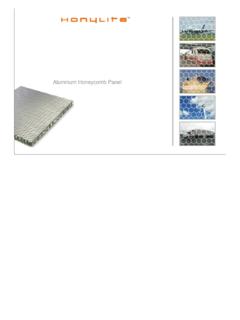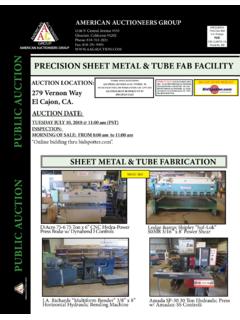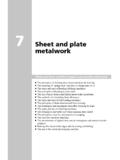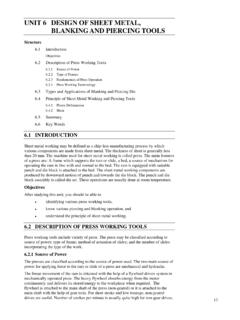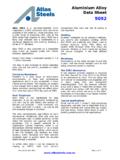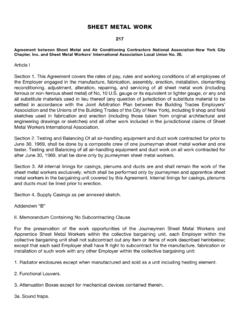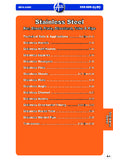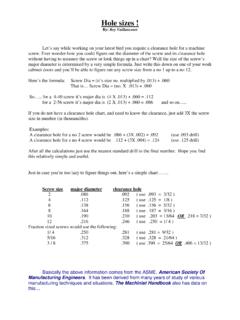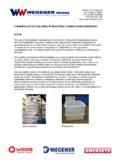Transcription of Cutting and Fabricating - Universal Metaltek
1 Cutting and Fabricating Sawing Blade geometry Tooth thickness approximately 2mm 4mm Tapered to the side to prevent jamming Tooth geometry Trapeze tooth / flat tooth Pitch (t) 10mm to 12mm Clearance angle ( ) 15 Rake angle ( ) 10 positive Maximum Cutting speed (v) 5,000 m / min. Maximum feed (s) 30m / min Routing HONYLITETM honeycomb panel can be easily routed on conventional routing machines. To avoid pressure marks on the surface, please use plastic or wood vice jaws when chucking the work-pieces. High speed steel or carbide tipped cutters suitable for aluminium have a wide tooth pitch, reduced and smooth grooves and small lip angles. The produce perfect cuts under the following conditions: High speed steel (HSS) Maximum Cutting speed 3,000m / min. Maximum feed 25m / min. Carbide tipped (CT) cutters Maximum Cutting speed 5,000m / min. Maximum feed 30m / min. Drilling HONYLITETM honeycomb panel can be drilled with twist drills normally used for aluminium and plastics on machines common for metals.
2 Drill material: High-speed steel (HSS) Tool geometry: Lip angle: 100 to 140 Pressing / Stamping HONYLITETM honeycomb panel can be pressed. The core is compressed without destroying the viscoplastic bonding system. This offers new processing and application possibilities. bending with a Roll bending machine HONYLITETM honeycomb panels of 6mm and 10mm thickness can be bent using three and four-roll bending machines with relatively close radii. The viscoplastic composite system enables radii to the produced from 300mm with a panel thickness of 6mm and from 700mm with a panel thickness of 10mm. The minimum diameter of the rolls should be 150mm. The values for adjusting the rolls have to be determined by trial. The bending rolls must be thoroughly cleaned of swerve before processing. The surface should be protected from damage by affixing plastic strips of 1mm to 2mm thickness during processing. Step- bending with bending presses HONYLITETM honeycomb panels can be shaped using the step- bending process.
3 The bending radius is determined by the stamping depth, the stamping distance and the panel thickness bending with saw cuts HONYLITETM honeycomb panels can be bent by applying saw cuts on the rear side of the panel. The required radius (r) is determined by the tooth thickness (s), the wall thickness (b), the panel thickness (d) and the number of saw cuts. To obtain a final thickness of , corresponding tracing rollers are attached to the saw blades of the vertical panel saws. Principally, bending should take place in the 1mm thick cover sheet. Folding Technique Folding with the bending press HONYLITETM honeycomb panels can be folded on bending presses using the tool geometry. When measuring cuts, the material gain for the corresponding thickness must be taken into consideration when making 90 folds. Panel Thickness (mm) bending Radius Outside (mm) Material Gain (mm) Folding Height min. (mm) 6 -4 20 10 -9 25 15 -13 30 20 -16 50 25 -18 50 Routing & Folding technique / producing corners and edges Corers and edges can be produced simply on HONYLITETM honeycomb panels using the routing and folding technique.
4 With all versions, a groove is routed on the rear of the panel into the 1mm thick cover sheet at the front. In version 1, as with HONYLITETM honeycomb panel, a cutter disk or forming cutter for V-groove 90 is used in the appropriate width. In version 2, the core of the panel is pre-cut using special tools. The grooves can be produced with circular panel saws. Normally, folding by hand is possible. If his is not possible, we recommend the use of a folding machine . Panel Edgings Producing edgings using panel edging sections Depending on the type of application, edging sections of various shapes can be attached to the ends of the HONYLITETM honeycomb panel. They are fixed to the panel by bonding, clamping or riveting to the cover sheet. Jointing and Fixing Techniques HONYLITETM honeycomb panel can be joined by means of standard processes used in metal and plastics technology. If HONYLITETM honeycomb panel is to be joined to structural parts of metals other than aluminium, or if fasteners ( bolts, screws) are to be used, the following materials guidelines should be observed: Fasteners and structural parts made of aluminium, plastic or stainless steel should be suitable for assembly with HONYLITETM honeycomb panels.
5 When using other materials, please insert insulating washers or apply protective a coating to prevent corrosion. Please take the thermal expansion of the panel into account for outdoor use of HONYLITETM honeycomb panel to avoid jamming or deformation. The minimum gap depends on the expected expansion of the panel. The linear thermal expansion of HONYLITETM honeycomb panel is determined by the aluminium cover sheets. At a temperature difference of 100 C, the longitudinal deformation is length/width. Rivets Not Penetrating the Panel Rivets generally must be anchored in the 1mm thick cover sheet of HONYLITETM honeycomb panel. Sections can be attached to HONYLITETM honeycomb panel with commercially available rivets for aluminium constructions. After drilling a blind hole of the same diameter as the rivet shank, the rivets can be anchored in the cover sheet. As a rule, rivets with stainless steel mandrel are used.
6 Rivets Penetrating the Panel HONYLITETM honeycomb panel can be joined together or fastened to other materials using rivet types commercial available for aluminium constructions. For outdoor use and for use in areas of high humidity, aluminium blind rivets with stainless steel mandrels are normally used to prevent ugly corrosive edges. When using aluminium blind rivets with steel mandrels, the mandrel should drop out after riveting. Countersunk rivets are not suitable. For outdoor use, please note: Use aluminium blind rivets that have been approved for construction with a 5mm shank diameter and an attachment head diameter of 11mm or 14mm. Please take the thermal expansion of the panel into account ( C). To avoid jamming, the hole in the panel must be large enough to allow for expansion. With the shank of the rivet fitting closely to edge of the hole, the attachment head must cover over 1mm of the area surrounding the hole.
7 Multi-step drills or sleeves having corresponding diameters are used for centrically drilling holes into the panel and the substructure and for centrically fitting the rivet. Rivet attachment jigs are used for fitting blind rivets without jamming allowing for a tolerance of Make sure the use rivet attachment jigs and rivets from the same manufacturer, as the height of the attachment head according to DIN 7337 may vary. The clamping thickness results from the thickness of the material to be riveted plus an additional value of 2mm to ensure that the closing head is perfectly formed. In accordance with this clamping thickness, the corresponding shaft length is determined in the tables provided by the rivet manufacturers. Important: During riveting, many factors may have an influence on the exact tolerance of the rivets of ( rivet head tolerance). We therefore recommend that you make a test on a fa ade panel. Please always remove the protective film around the riveting area prior to riveting.
8 Blind Rivet Nuts and Bolts Blind rivet nuts and bolts are threaded elements performing the function of a blind rivet and a nut or bolt (screw). There are various types of rivet head and materials which can be selected depending on the intended application. The blind rivet nuts or bolts are inserted in blind holes drilled in one side of the HONYLITETM honeycomb panel. Subsequent fitting with a tool is fast and cost-effective. Due to the minimum shaft length of 11mm, these fixtures can only be used for a panel thickness of 15mm or more. As a rule, the rivet must be anchored in the 1mm thick cover sheet. Threaded Fasteners for Outdoor Use Please take the thermal expansion of the panel into account when using threaded fasteners outdoors. To avoid jamming, the hole diameter in the panel must allow for the expansion. Fastening without jamming is possible with fascia screws made of stainless steel with sealing washer that have been approved for construction.
9 The screws must be suitable for the corresponding substructure. The screws should be tightened with a torque wrench or screw driver so that the sealing washer is placed on the panel for sealing the bore hole without exerting pressure onto the panel. Multi-step drills or sleeves having corresponding diameters are used for centrically drilling holes into the panel and the substructure and for centrically fitting the rivet. Important: Please always remove the protective film prior to screwing Flowdrill Process Flowdrills are polygonally ground carbide-tipped tools. The Flowdrill presses against the thin metallic material with a relatively high rotational speed and axial pressure. The generated heat makes the material soft enough to push the Flowdrill through the work piece thus forming a hole. The material which is mainly displaced in process direction forms a bushing at the same time. The length of the bush can be 3 to 5 times the original material thickness.
10 In the case of threaded fasteners higher pull-out strength can be obtained due to the larger contact area of the screws. The flat / short Flowdrill type is used for HONYLITETM honeycomb panel. These drills are suitable for thin materials and remove protruding material from the panel surface at the same time. Clamp Connections Clamp connections incorporating aluminium or plastics are particularly suitable for HONYLITETM honeycomb panel. They generally consist of two parts with the clamping effect achieved by bolting. Various designs of clamping element are used for display and store fitting purposes. Any suitable connection or shock-resistant frame can be easily be made with aluminium sections. For fascia cladding applications special aluminium sections are provided for clamp connections. Gluing Tapes / Velcro Tapes Double-sided tapes (such as the 3M-VHB high capacity jointing systems) can be used for the above applications with low tensile or transversal strength requirements.
